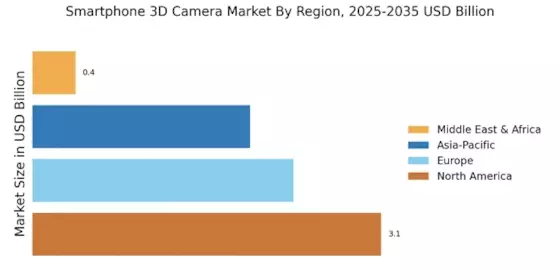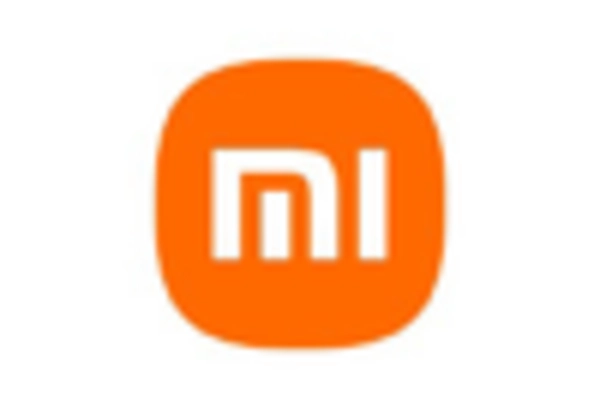Rising Popularity of Social Media
The Smartphone 3D Camera Market is significantly influenced by the rising popularity of social media platforms that prioritize visual content. As users increasingly seek to create and share immersive experiences, the demand for smartphones equipped with 3D cameras is likely to grow. Platforms such as Instagram and Snapchat have introduced features that allow users to post 3D images and videos, thereby encouraging smartphone manufacturers to enhance their offerings. This trend is evident in the increasing number of 3D camera-enabled devices launched in recent years, with projections indicating that the market could expand at a compound annual growth rate (CAGR) of around 15% through 2027. Consequently, the integration of 3D cameras into smartphones is becoming a key differentiator for brands aiming to capture the attention of social media enthusiasts.
Technological Innovations in Imaging
The Smartphone 3D Camera Market is experiencing a surge in technological innovations that enhance imaging capabilities. Advancements in sensor technology, such as the development of high-resolution lenses and improved image processing algorithms, are driving the market forward. For instance, the integration of dual-lens systems allows for more accurate depth perception and 3D rendering. As a result, manufacturers are increasingly investing in research and development to create smartphones that offer superior photographic experiences. This trend is reflected in the growing number of devices equipped with 3D cameras, which is projected to reach a market size of approximately USD 10 billion by 2026. Such innovations not only attract tech-savvy consumers but also appeal to professionals in fields like photography and videography, thereby expanding the market's reach.
Increased Investment in Mobile Photography
The Smartphone 3D Camera Market is experiencing increased investment in mobile photography, as brands recognize the importance of high-quality imaging in attracting consumers. With the proliferation of smartphones, manufacturers are focusing on enhancing camera features to differentiate their products. This trend is underscored by the fact that nearly 50% of consumers consider camera quality as a primary factor when purchasing a smartphone. As a result, companies are allocating substantial resources to develop advanced 3D camera technologies that cater to this demand. The market is projected to grow significantly, with estimates suggesting a value of USD 12 billion by 2028. This investment not only enhances the capabilities of smartphones but also positions them as essential tools for both casual users and professional photographers, thereby driving the Smartphone 3D Camera Market.
Consumer Demand for Enhanced User Experiences
The Smartphone 3D Camera Market is witnessing a shift in consumer preferences towards enhanced user experiences. As consumers become more discerning, they are increasingly seeking smartphones that offer unique features, such as 3D photography and videography capabilities. This demand is driven by the desire for more engaging content creation, particularly among younger demographics who value creativity and innovation. Market data suggests that approximately 30% of consumers are willing to pay a premium for smartphones with advanced camera features, including 3D capabilities. This trend indicates a growing recognition of the value that 3D cameras bring to personal and professional use, thereby propelling manufacturers to invest in this technology. As a result, the Smartphone 3D Camera Market is likely to see continued growth as brands respond to these evolving consumer expectations.
Integration of Augmented Reality Applications
The Smartphone 3D Camera Market is increasingly benefiting from the integration of augmented reality (AR) applications. As AR technology becomes more mainstream, the demand for smartphones equipped with 3D cameras is expected to rise. These cameras enable users to interact with digital content in a more immersive manner, enhancing gaming, shopping, and educational experiences. For instance, AR applications that utilize 3D camera capabilities can create realistic simulations, which are appealing to both consumers and businesses. Market analysts predict that the AR market will reach USD 198 billion by 2025, further driving the need for compatible devices. Consequently, smartphone manufacturers are likely to prioritize the development of 3D camera technology to meet the growing demand for AR applications, thereby expanding the Smartphone 3D Camera Market.


















Leave a Comment